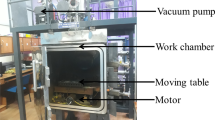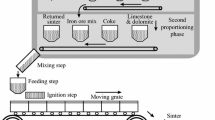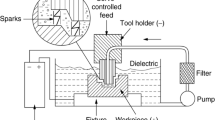Abstract
Welding process does not possess a good environmental image due to fumes, noise and other health hazards. But, it has been widely applied and is irreplaceable as far as structural industries are concerned. In welding process, many factors are responsible for environmental burdens, of which this study investigates and optimizes process parameters. Based on the pilot study, operating levels for parameters like current, voltage and welding speed, and various responses were identified. Further, the responses considered in the study include spatter, slag, fume generation rate, particulates and power consumption. A full factorial design of three factors at five levels requires 125 experiments for a complete analysis; however the conduct of a full factorial design experiment is expensive and consumes much time. Hence, \(\hbox {L}_{27}\) orthogonal design was adopted for three inputs and five levels and 27 experiments were conducted. Further, five back propagation neural network model with network structure of 3-12-1 was individually developed to predict responses. \(\hbox {R}^{2}\) values obtained for back propagation neural network model pertaining to slag, spatter, power consumption, fume generation rate and particulate formation are 0.99, 0.99, 0.989, 0.965 and 0.97 respectively. The responses for full factorial interaction were simulated. Fuzzy based grey relational analysis was used to optimize process parameters. Finally, life cycle assessment methodology outlined by ISO 14040 and 14044 was adopted to quantify the improvement in environmental performance due to parameter optimization. Thus, the proposed methodology helps to improve environmental performance of the manufacturing process with the experiments conducted using partial factorial design. Apart from environmental benefits, economic benefits and man hours saving are attained without compromising accuracy.










Similar content being viewed by others
Abbreviations
- SMAW:
-
Submerged metal arc welding
- BPNN:
-
Back propagation neural network
- FGRA:
-
Fuzzy based grey relational analysis
- LCA:
-
Life cycle assessment
- FGR:
-
Fume generation rate
- ANOVA:
-
Analysis of variance
- EIA:
-
Environment impact analysis
References
Ageron, B., Gunasekaran, A., & Spalanzani, A. (2012). Sustainable supply management: An empirical study. International Journal of Production Economics, 140(1), 168–182.
Ahilan, C., Kumanan, S., Sivakumaran, N., & Dhas, J. E. R. (2013). Modeling and prediction of machining quality in CNC turning process using intelligent hybrid decision making tools. Applied Soft Computing, 13(3), 1543–1551.
ANSI/AWS F1. 5. Methods for sampling and analyzing gases from welding and allied PROCeSSES. American Welding Society. Miami, Florida.
ANSI, AWS F1.2. (1992). Laboratory method for measuring fume generation rates and total fume emission of welding and allied processes. American Welding Society. Miami, Florida.
Asiltürk, İ., & ÇUnkaş, M. (2011). Modeling and prediction of surface roughness in turning operations using artificial neural network and multiple regression method. Expert Systems with Applications, 38(5), 5826–5832.
AWS A3.0:2001. (2001). Standard welding terms and definitions. Including Terms for Adhesive Bonding, Brazing, Soldering, Thermal Cutting, and Thermal Spraying, an American National Standard, Approved by American National Standards Institute American Welding Society, Miami, FL, 41 pp.
Çaydaş, U., & Hasçalık, A. (2008). A study on surface roughness in abrasive waterjet machining process using artificial neural networks and regression analysis method. Journal of Materials Processing Technology, 202(1), 574–582.
Chu, W. H., & Tung, P. C. (2005). Development of an automatic arc welding system using a sliding mode control. International Journal of Machine Tools and Manufacture, 45(7), 933–939.
Deng, J. L. (1982). Control problems of grey systems. Systems & Control Letters, 1(5), 288–294.
European Commission. (2010). Publications of the European Platform of LCA including the ILCD handbook: Brussels, Belgium. http://lct.jrc.ec.europa.eu/publications. Accessed on 30 August 2013.
Foolmaun, R. K., & Ramjeawon, T. (2008). Life cycle assessment (LCA) of PET bottles and comparative LCA of three disposal options in Mauritius. International Journal of Environment and Waste Management, 2(1), 125–138.
Goel, V., Liao, T. W., & Lee, K. S. (1993). A shielded metal arc welding expert system. Computers in Industry, 21(2), 121–129.
Gunasekaran, A., & Spalanzani, A. (2012). Sustainability of manufacturing and services: Investigations for research and applications. International Journal of Production Economics, 140(1), 35–47.
Guresen, E., Kayakutlu, G., & Daim, T. U. (2011). Using artificial neural network models in stock market index prediction. Expert Systems with Applications, 38(8), 10389–10397.
Hou, J. (2010). Grey relational analysis method for multiple attribute decision making in intuitionistic fuzzy setting. Journal of Convergence Information Technology, 5(10), 194–199.
ISO, 14040. (2006). Environmental management-life cycle assessment-principles and framework. British Standards Institution, London.
ISO.14044. (2006). Environmental management—life cycle assessment—requirements and guidelines. International Organization for Standardization.
Kaebernick, H., & Kara, S. (2006). Environmentally sustainable manufacturing: A survey on industry practices. In: Proceedings of 13th CIRP international conference on life cycle engineering, pp. 19–28.
Kasah, T. (2014). LCA of a newsprint paper machine: A case study of capital equipment. The International Journal of Life Cycle Assessment, 19(2), 417–428.
Khashei, M., & Bijari, M. (2010). An artificial neural network \((<i>\, p</i> <i>\, d</i> <i>\, q</i>)\) model for timeseries forecasting. Expert Systems with Applications, 37(1), 479–489.
Kovac, P., Rodic, D., Pucovsky, V., Savkovic, B., & Gostimirovic, M. (2013). Application of fuzzy logic and regression analysis for modeling surface roughness in face milliing. Journal of Intelligent Manufacturing, 24(4), 755–762.
Kumar, B. P., & Vijayakumar, Y. (2012). Optimization of shielded metal arc welding parameters for welding of pipes by using taguchi approach. International Journal of Engineering Science and Technology, 4(5), 2083–2088.
Kumru, M., & Kumru, P. Y. (2014). A fuzzy ANP model for the selection of 3D coordinate-measuring machine. Journal of Intelligent Manufacturing. doi:10.1007/s10845-014-0882-y.
Kuo, R. J., Tseng, Y. S., & Chen, Z. Y. (2014). Integration of fuzzy neural network and artificial immune system-based back-propagation neural network for sales forecasting using qualitative and quantitative data. Journal of Intelligent Manufacturing. doi:10.1007/s10845-014-0944-1.
Kuo, R. J., Wang, Y. C., & Tien, F. C. (2010). Integration of artificial neural network and MADA methods for green supplier selection. Journal of Cleaner Production, 18(12), 1161–1170.
Lin, J. L., & Lin, C. L. (2002). The use of the orthogonal array with grey relational analysis to optimize the electrical discharge machining process with multiple performance characteristics. International Journal of Machine Tools and Manufacture, 42(2), 237– 244.
Linke, B. S. (2013). Sustainability indicators for grinding applied to dressing strategies. Journal of Manufacturing Science and Engineering, 135(5), 054502.
Liu, N. M., Horng, J. T., & Chiang, K. T. (2009). The method of grey-fuzzy logic for optimizing multi-response problems during the manufacturing process: A case study of the light guide plate printing process. The International Journal of Advanced Manufacturing Technology, 41(1–2), 200–210.
Ljungberg, L. Y. (2007). Materials selection and design for development of sustainable products. Materials & Design, 28(2), 466– 479.
Pandey, R. K., & Panda, S. S. (2014). Optimization of bone drilling parameters using grey-based fuzzy algorithm. Measurement, 47, 386–392.
Pang, B., & Bai, S. (2013). An integrated fuzzy synthetic evaluation approach for supplier selection based on analytic network process. Journal of Intelligent Manufacturing, 24(1), 163–174.
Phadke, M. S. (1989). Quality engineering using robust design. Englewood Cliffs, NJ: prentice Hall.
Praveen, P., Yarlagadda, P. K. D. V., & Kang, M. J. (2005). Advancements in pulse gas metal arc welding. Journal of Materials Processing Technology, 164, 1113–1119.
Raja, A., Eswaran, & Rajasekar, A. (2012). Automation of welding in fabrication sector—an Indian experience. In DVS international conference on welding automation, Germany.
Ramadhas, A. S., Jayaraj, S., Muraleedharan, C., & Padmakumari, K. (2006). Artificial neural networks used for the prediction of the cetane number of biodiesel. Renewable Energy, 31(15), 2524–2533.
Rubin, R. S., Castro, M. A. S. D., Brandão, D., Schalch, V., & Ometto, A. R. (2014). Utilization of life cycle assessment methodology to compare two strategies for recovery of copper from printed circuit board scrap. Journal of Cleaner Production, 64, 297–305.
Saaty, T. L. (1980). The analytic hierarchy process. New York: McGraw-Hill Book Co.
Saaty, T. L. (1988). What is the analytic hierarchy process?. Berlin, Heidelberg: Springer.
Singh, A., Datta, S., Mahapatra, S. S., Singha, T., & Majumdar, G. (2013). Optimization of bead geometry of submerged arc weld using fuzzy based desirability function approach. Journal of Intelligent Manufacturing, 24(1), 35–44.
Tandon, R. K., Ellis, J., Crisp, P. T., & Baker, R. S. (1984). Fume generation and melting rates of shielded metal arc welding electrodes. Welding Journal, 63(8), 263s–266s.
Taormina, R., Chau, K. W., & Sethi, R. (2012). Artificial neural network simulation of hourly groundwater levels in a coastal aquifer system of the Venice lagoon. Engineering Applications of Artificial Intelligence, 25(8), 1670–1676.
Tsai, C. P., & Lee, T. L. (1999). Back-propagation neural network in tidal-level forecasting. Journal of Waterway, Port, Coastal, and Ocean Engineering, 125(4), 195–202.
Tsai, K. M., & Luo, H. J. (2014). An inverse model for injection molding of optical lens using artificial neural network coupled with genetic algorithm. Journal of Intelligent Manufacturing. doi:10.1007/s10845-014-0999-z.
Tseng, M. L. (2010). Using linguistic preferences and grey relational analysis to evaluate the environmental knowledge management capacity. Expert Systems with Applications, 37(1), 70–81.
Tybout, J. R., & Westbrook, M. D. (1995). Trade liberalization and the dimensions of efficiency change in Mexican manufacturing industries. Journal of International Economics, 39(1), 53–78.
Ueguri, S., Hara, K., & Komura, H. (1985). Study of metal transfer in pulsed GMA welding. Welding Journal, 64(8), 242–250.
Vimal, K. E. K., & Vinodh, S. (2012). Leanness evaluation using IF-THEN rules. The International Journal of Advanced Manufacturing Technology, 63(1–4), 407–413.
Vimal, K. E. K., & Vinodh, S. (2013). Development of checklist for evaluating sustainability characteristics of manufacturing processes. International Journal of Process Management and Benchmarking, 3(2), 213– 232.
Vimal, K. E. K., Vinodh, S., & Raja, A. (2015). Modelling, assessment and deployment of strategies for ensuring sustainable shielded metal arc welding process—a case study. Journal of Cleaner Production. doi:10.1016/j.jclepro.2015.01.049.
Xiong, J., Zhang, G., Hu, J., & Wu, L. (2014). Bead geometry prediction for robotic GMAW-based rapid manufacturing through a neural network and a second-order regression analysis. Journal of Intelligent Manufacturing, 25(1), 157–163.
Yang, Y. S., Shih, C. Y., & Fung, R. F. (2014). Multi-objective optimization of the light guide rod by using the combined Taguchi method and Grey relational approach. Journal of Intelligent Manufacturing, 25(1), 99–107.
Yu, J. B., Yu, Y., Wang, L. N., Yuan, Z., & Ji, X. (2014). The knowledge modeling system of ready-mixed concrete enterprise and artificial intelligence with ANN-GA for manufacturing production. Journal of Intelligent Manufacturing. doi:10.1007/s10845-014-0923-6.
Zadeh, L. A. (1965). Fuzzy sets. Information and Control, 8(3), 338–353.
Zain, A. M., Habibollah, H., & Safian, S. (2011). Estimation of the minimum machining performance in the abrasive waterjet machining using integrated ANN-SA. Expert Systems with Applications, 38(7), 8316–8326.
Zhou, J., Duan, Z., Li, Y., Deng, J., & Yu, D. (2006). PSO-based neural network optimization and its utilization in a boring machine. Journal of Materials Processing Technology, 178(1), 19–23.
Zimmer, A. T., Baron, P. A., & Biswas, P. (2002). The influence of operating parameters on number-weighted aerosol size distribution generated from a gas metal arc welding process. Journal of Aerosol Science, 33(3), 519–531.
Conflict of interest
The authors declare that they have no conflict of interest.
Author information
Authors and Affiliations
Corresponding author
Appendix
Rights and permissions
About this article
Cite this article
Vimal, K.E.K., Vinodh, S. & Raja, A. Optimization of process parameters of SMAW process using NN-FGRA from the sustainability view point. J Intell Manuf 28, 1459–1480 (2017). https://doi.org/10.1007/s10845-015-1061-5
Received:
Accepted:
Published:
Issue Date:
DOI: https://doi.org/10.1007/s10845-015-1061-5




